Barrhaven Homes: Stop Spring Tent Caterpillars Early
Seeing pests on your property? Don't wait for damage!
Request a Free Quote Today!Quick Guide to Stopping Tent Caterpillars:
- Identify Early: Look for shiny, dark egg masses on twigs in winter/early spring.
- Scrape Eggs: Gently remove egg masses and destroy them (crush or soapy water).
- Remove Small Tents: Twist young tents off branches (morning/evening) and dunk in soapy water.
- Use Btk (If Needed): Apply *Bacillus thuringiensis* var. *kurstaki* to leaves around tents for young caterpillars only.
- Boost Tree Health: Maintain healthy trees with proper watering and soil care.
Introduction: Those Fuzzy Spring Squatters in Barrhaven - Let's Talk Tent Caterpillars!
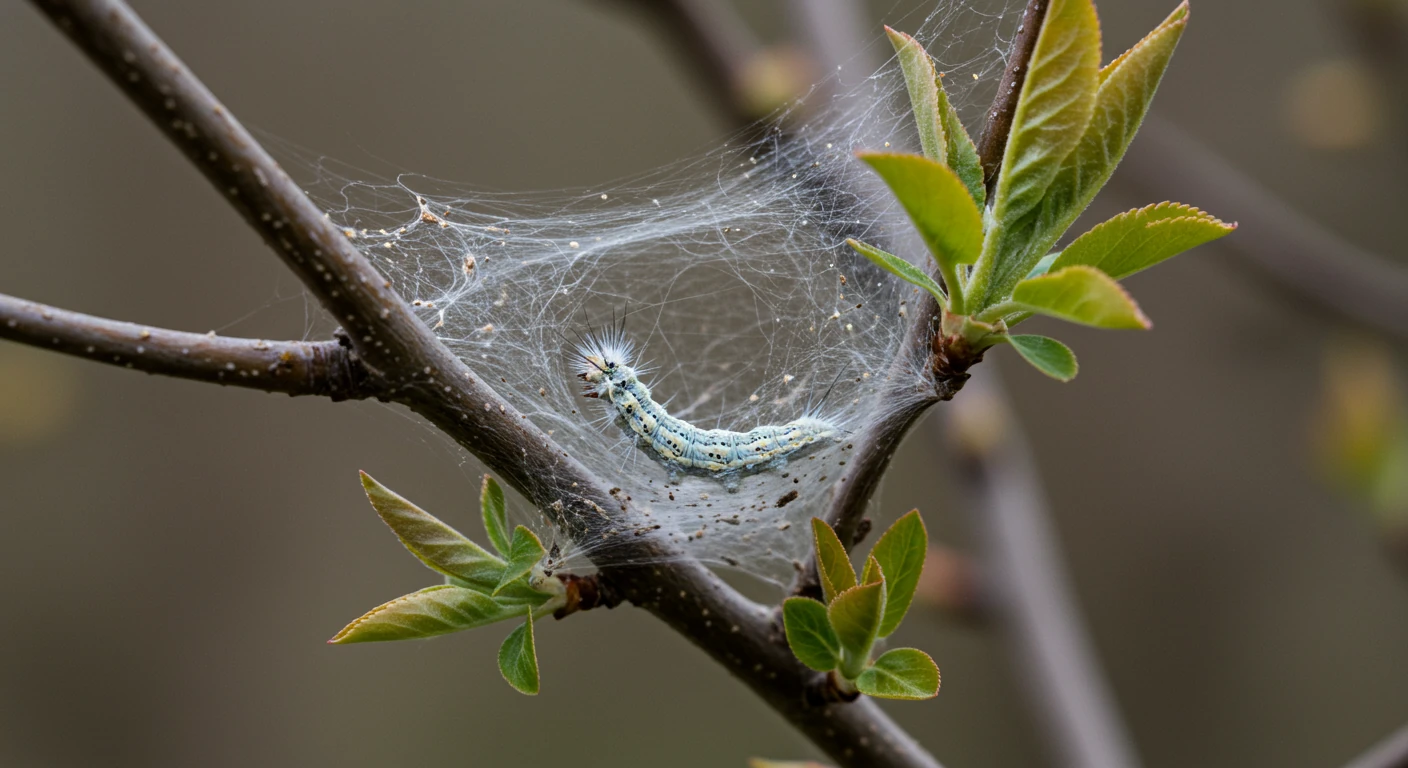
Hey Barrhaven neighbours! Spring is finally shaking off winter, the snow is *mostly* a memory, and our gardens are stirring. We're all eager to get back to our landscaping projects and enjoy our yards. But wait... what’s that silky, webby bundle starting to grow in your prized crabapple or maybe that young ornamental cherry tree? Ah yes, let's talk about those fuzzy spring squatters that show up without an invitation: the Eastern Tent Caterpillar.
Okay, let's admit it – they're a bit on the creepy-crawly side, and seeing dozens (or hundreds!) wriggling in those communal tents can certainly trigger an "ick" response! It's a common sight across Ottawa in the spring, and Barrhaven definitely gets its share of these temporary residents. These caterpillars are early risers, building their tents in the crooks of branches just as your trees desperately want to unfurl their beautiful new leaves for the season. We often hear about them during calls for Barrhaven yard cleanup services.
While they usually don't kill a healthy, mature tree, a heavy infestation can make your favourite trees look pretty sad and stressed, munching away on that fresh spring growth. Ignoring them isn't the best garden maintenance strategy if you value vigorous, leafy trees. The good news? Early action in the spring, *before* the tents get huge and the caterpillars spread out, is key! Don't fret, though. Understanding these leaf-munchers and knowing *when* and *how* to manage them makes all the difference. Let's get prepared to protect our Barrhaven trees!
Who Are These Tent Crashers Anyway? Meet the Eastern Tent Caterpillar
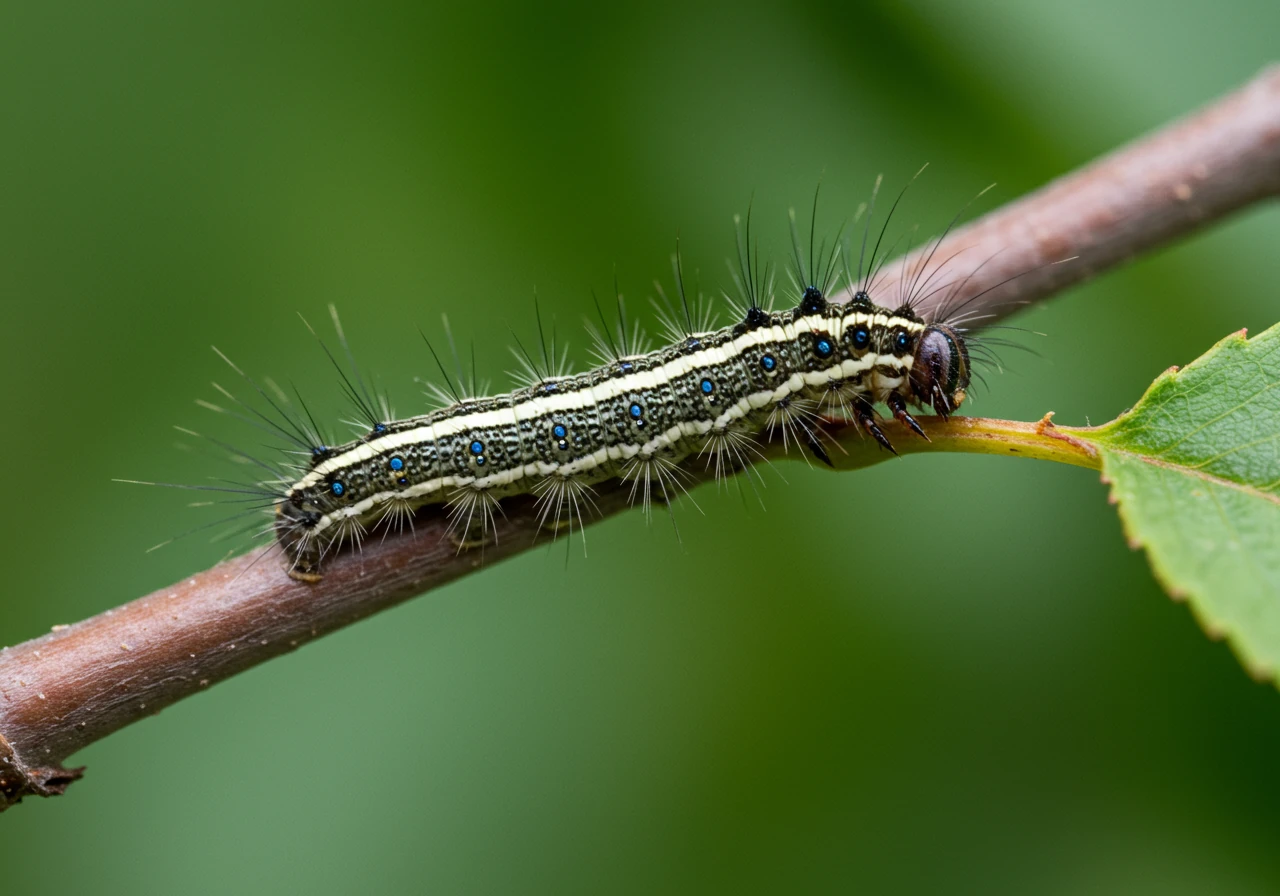
Okay, so you've spotted those silky tents setting up shop in your favourite tree. Let's formally introduce the uninvited guests: Malacosoma americanum, or as we commonly know them, the Eastern Tent Caterpillar (ETC). These aren't exotic invaders; they're native party animals, especially common around Ottawa, popping up frequently in neighbourhoods like Barrhaven and even over in Nepean. Clients requesting Ottawa property cleanup services often ask about managing them.
What do they look like?
Well, they're fuzzy and kinda cute... if you ignore the hundreds wriggling together! The caterpillars themselves are dark with a distinctive white stripe down their back, flanked by yellow-brown lines and rows of pale blue oval spots. They can grow up to about 5 cm (2 inches) long when fully grown. They live communally in those silk tents, usually built in the crotch of branches where they meet the trunk or a larger limb. Think of it as their very own fuzzy apartment complex, providing shelter from rain and predators (though birds still find them!).
Their Sneaky Life Cycle
Understanding their schedule is key to stopping the party early. Their life cycle has a few key stages relevant to your gardening efforts:
- Egg Stage: Surprise! They actually spend most of the year (late summer, fall, and all winter) as tiny eggs. The female moth lays these eggs in a shiny, dark brown or black, styrofoam-like band wrapped tightly around small twigs of host trees. Spotting and carefully scraping off these egg masses *before* spring warmth hits is a pro gardening move and avoids the problem altogether! This is a task sometimes included in city garden maintenance services.
- Larval (Caterpillar) Stage: As soon as those first tender leaves appear in spring (often April or early May in the Ottawa area), the eggs hatch. These newly hatched caterpillars waste no time and immediately get busy building their waterproof silk tent for protection. They are social critters, leaving the tent during the day (usually mornings and evenings) to munch on leaves and returning at night or during cold, rainy weather. This feeding and tent-building stage is when we notice them most, and it lasts about 4 to 6 weeks.
- Pupal Stage & Moth Stage: After stuffing themselves for weeks, the fully grown caterpillars leave the tree and wander off to find a protected place (like under bark, leaf litter, or even on fences and buildings) to spin a yellowish-white cocoon. Inside, they transform into pupae. About two weeks later, reddish-brown moths emerge (usually in early summer), mate, and the females lay those egg masses for *next* year's generation, starting the cycle all over again.
Tent Caterpillar Lifecycle Timeline
Late Summer - Early Spring: Egg Stage
Tiny eggs overwinter in dark, shiny bands wrapped around twigs.
Early Spring (April/May): Hatching
Eggs hatch as tree buds open. Small larvae emerge.
Spring (April - June): Larval Stage
Caterpillars build tents, feed on leaves, and grow for 4-6 weeks.
Early Summer (June/July): Pupation
Mature caterpillars leave trees, spin cocoons in protected spots.
Summer (July): Moth Stage
Adult moths emerge, mate, and lay eggs for the next generation.
Favourite Hangouts (Host Trees)
ETCs aren't super picky eaters, but they definitely have favourites, especially trees in the Rose family (Rosaceae). In Barrhaven and surrounding areas like Manotick or Greely, keep an extra eye on:
- Cherry trees (especially wild cherry, chokecherry, but also ornamental varieties)
- Apple and Crabapple trees
- Hawthorn trees
- Less commonly, they might also feed on Pear, Plum, Peach, Ash, Birch, Maple, and Oak trees if their preferred choices aren't nearby or are already stripped bare. Maintaining diverse plantings can sometimes mitigate damage, a consideration in our material selection process.
The Damage Report
Seeing a tree covered in tents and crawling caterpillars can be alarming, but here’s some slightly comforting news: ETCs rarely kill healthy, established trees. Their main crime is defoliation – eating the leaves. Since this happens early in the growing season, most healthy trees have enough energy reserves to push out a second flush of leaves later in the spring or early summer, though this does put stress on the tree.
However, repeated heavy infestations year after year, or attacks on very young, newly planted, or already stressed trees, can weaken them significantly, making them more vulnerable to other pests, diseases, or drought. Plus, let's be honest, those large, messy tents and bare branches aren't exactly enhancing your landscaping aesthetic! It certainly detracts from the intentional beauty you might cultivate using strategies like Barrhaven spring espalier garden art techniques. Early identification and action, much like the assessments done for professional Barrhaven commercial spring cleanup services, helps prevent bigger headaches later. You want to be able to fully enjoy your yard features, perhaps thinking ahead to cozy evenings inspired by Barrhaven fire pit design tips for fall enjoyment, not worrying about stressed or stripped trees. Protecting these valuable landscape assets contributes to overall property enjoyment and value, much like well-planned structures discussed in Barrhaven fall pergola ideas to boost property value. If an infestation seems particularly widespread or difficult to manage on your own, remember that professional help is available through our landscape maintenance services.
Playing Detective: Spotting Trouble Before the Tents Go Up
Okay, let's put on our detective hats! Before those fuzzy caterpillars even *think* about building their silky tent condos in your favourite trees, they leave clues. Finding these clues – their egg masses – is your secret weapon for preventing a full-blown invasion later in the spring. Think of it as pre-emptive gardening magic!
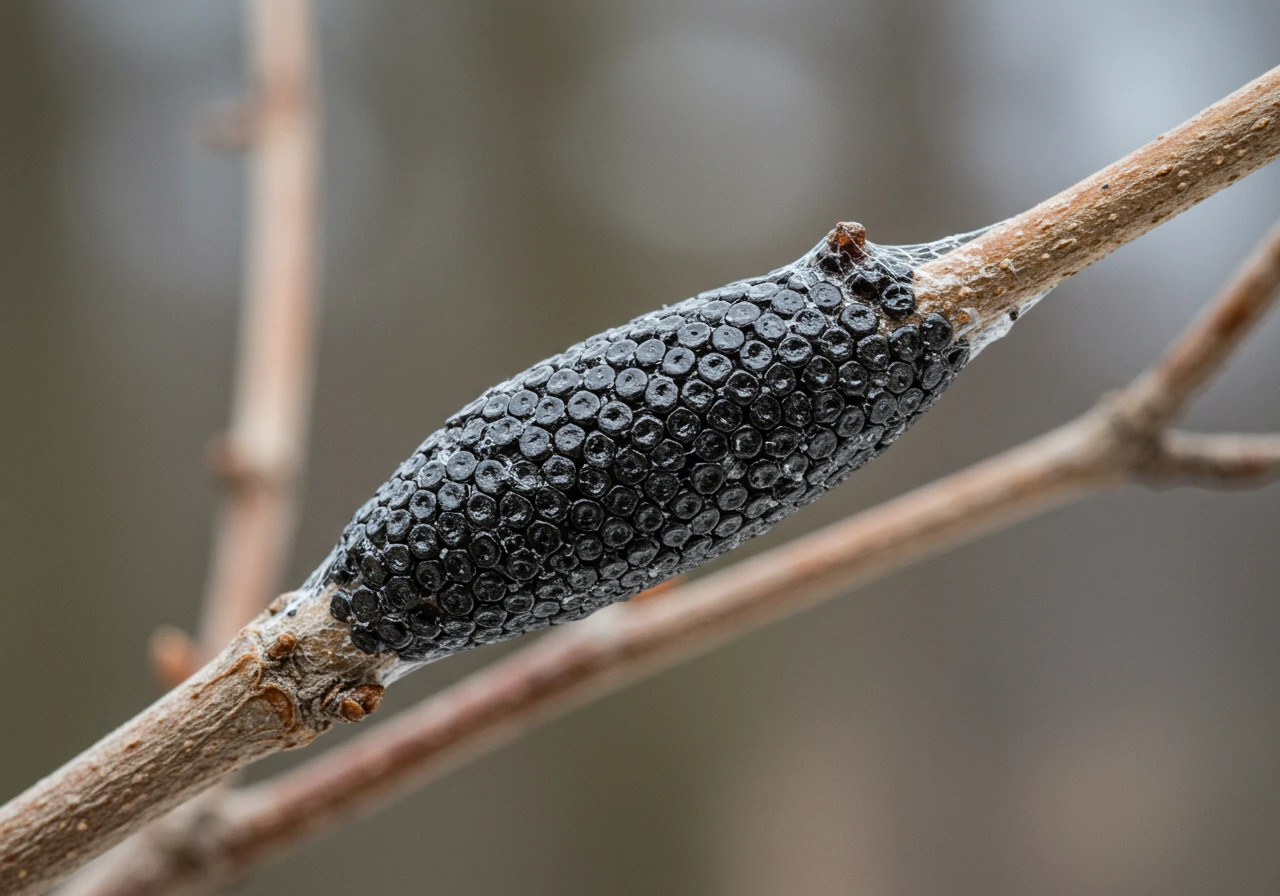
When to Play Detective:
The best time for this mission in Ottawa and surrounding areas like Manotick or even older parts of Barrhaven with established trees, is during the late fall, winter, or very early spring. Why then? Because the leaves are off deciduous trees, making the twigs much easier to see! Aim for a clear day when the sun is out – it helps highlight these sneaky egg bands. Once the buds start swelling, usually around late March or early April depending on the year, those eggs are getting ready to hatch, so your window for easy spotting is closing.
What You're Looking For:
Forget magnifying glasses (mostly!). You're searching for small, shiny, dark grey or brownish bands wrapped tightly around slender twigs – usually twigs about the thickness of a pencil or slightly larger. These bands are roughly 1.5 to 2 cm (about ½ to ¾ inch) wide. Up close, they look a bit like dark, hardened foam or varnish. They're surprisingly well-camouflaged, blending in with the bark, but once you spot one, you'll know what to look for.
Where to Snoop Around:
Focus your search on the preferred host trees mentioned earlier – especially fruit trees like wild cherry, chokecherry, apple, and crabapple, which are common landscape features. Hawthorns are another favourite.
- Scan the lower branches first, as they're easiest to reach and inspect.
- Look closely at twigs on the outer parts of the tree.
- Pay special attention to trees that had caterpillar tents last year – chances are, the moths laid eggs nearby for this year's generation. Similar vigilance is needed for maintaining overall lawn health, where consistent lawn care is key.
Your Simple Scouting Calendar:
- Late October - November: After leaf fall, do an initial sweep.
- January - February: Pick a sunny winter day for another look. Snow cover might limit access to lower branches, but higher branches are visible. This is often a great time as there's little else demanding your landscaping attention!
- Early March: Your final check before bud break! This gives you one last chance before hatching.
Why Bother Playing Detective?
Early detection is HUGE! Finding and removing (gently scrape them off with a dull knife or your fingernail, being careful not to damage the twig) just one egg mass eliminates hundreds of potential caterpillars *before* they hatch and start munching. It's way easier than dealing with sticky tents full of wriggling larvae later. Consistent scouting is a key part of proactive tree care. If the task seems overwhelming, or if you're already scheduling spring work, integrating this check can be part of a larger plan. Many homeowners find bundling tasks makes sense, similar to arranging for a thorough thorough Barrhaven yard cleanup service that prepares the whole property for the season. Tackling potential pests early prevents bigger headaches and protects your valuable trees. It’s a strategy employed across the region, whether you need an Ottawa property cleanup service or support further out, like expert property cleanup in areas like expert property cleanup in areas like Marionville. Keeping an eye out is a simple, effective step. If you find widespread issues or need help assessing tree health, considering professional comprehensive landscape maintenance services can provide peace of mind. Ultimately, vigilance helps maintain the beauty and health of our urban greenery, something a reliable city yard cleanup service also contributes to. So, grab your coat on a clear day and go inspect those twigs – your trees will thank you! Find a local service like ours via Google.
Your Anti-Caterpillar Toolkit: Prevention is Key!
Okay, team! We've played detective and hopefully spotted those sneaky egg masses we talked about in the last section. Now, let's talk about building your anti-caterpillar toolkit because, let's face it, stopping these fuzzy munchers *before* they hatch is way less messy than dealing with sticky tents later. Prevention really is key, especially in areas like Richmond where beautiful mature trees are part of the charm. Think of this as your spring training regime for tree protection!
Weapon #1: The Search and Destroy Mission (Egg Mass Removal)
Your number one weapon? Good old-fashioned elbow grease! Physically removing those egg masses during the dormant season is super effective and completely non-toxic. Diligent homeowners across Ottawa know this is a worthwhile chore. Here's your step-by-step guide:
- Timing is Everything: Remember, late fall, winter, or *very* early spring (before buds swell – think anytime from November through early April, weather permitting) is your window. You need those branches bare to see clearly!
- Spot 'Em: Zero in on those dark, shiny, almost tar-like bands wrapped tightly around small twigs (usually pencil-thick or slightly larger). They look a bit like hardened, greyish-black styrofoam.
- Gentle But Firm Removal: Carefully scrape the entire egg mass off the twig. Your fingernail might do the trick on smaller twigs, or use a *dull* knife blade or even a stiff-bristled brush. The goal is to dislodge the eggs without gouging or damaging the tree's bark. Be gentle with your tree friend!
- Destroy the Evidence: This is crucial! Don't just flick the masses onto the ground. Those eggs are tough cookies and can still survive. Crush them thoroughly underfoot (if you don't mind the crunch) or, better yet, drop them into a container of soapy water to ensure they're really done for. Giving those hundreds of future caterpillars the boot feels pretty satisfying!
Weapon #2: Dormant Oil Spray (Strategic Suffocation)
Another highly effective tool in your preventative gardening arsenal is dormant oil, often labelled as horticultural oil. When applied correctly, this oil coats and suffocates overwintering insect eggs (like ETCs) and some pests before they become active.
- The Catch? Timing! This is *absolutely critical* for Ottawa's sometimes fickle spring climate. Dormant oil *must* be applied when the tree is fully dormant (no green tips showing, no swollen buds) *but* when temperatures are forecast to stay *above freezing* (usually needing 4°C or higher, check the label!) for at least 24 hours *after* you spray. This often means a very specific window in late March or early April here. Applying during freezing temps can harm the tree, and applying too late, once buds start opening, can damage the emerging leaves or flowers. Miss the window, and you miss your chance for this method.
- Safety & Application: Always, always, *always* read and follow the product label instructions *exactly* for mixing rates and application procedures. Wear appropriate safety gear (gloves, eye protection, maybe a mask). Spray on a calm, dry day – wind causes drift (meaning the oil doesn't hit its target and could land where you don't want it), and rain will wash it off before it works. Thorough coverage of twigs and branches, especially where egg masses might be hiding, is key to success.
Long-Term Strategy: Healthy Trees & Smart Choices
While direct intervention is great, long-term prevention involves good landscaping practices:
- Consider Resistance: If planting new trees, especially in areas prone to ETCs like near wild cherry stands, you might lean towards trees they favour less, such as oaks, maples, ashes, or conifers. They aren't immune, but they're not the preferred buffet.
- Boost Tree Health: A strong, healthy tree is much better equipped to handle some defoliation and push out new leaves. Focus on good fundamentals:
- Healthy Soil: Good soil structure and fertility are the foundation. Ensure proper drainage, amend soil with compost if needed, and maintain a layer of mulch around the base (but not touching the trunk!). Healthy soil is just as vital for trees as it is for establishing a beautiful lawn via professional sod installation, where proper ground preparation is paramount. Learn more about our soil preparation techniques.
- Water Wisely: Provide adequate water, especially during dry spells or for newly planted trees.
- Keep it Clean: Basic yard hygiene helps! Regularly removing fallen leaves and debris can reduce overwintering spots for various pests and diseases. It's all part of holistic property care, whether handled through routine visits from a city garden maintenance service or seasonal efforts like a thorough city yard cleanup service. This applies everywhere, from suburban yards to properties needing a dedicated Metcalf property cleanup service.
Ultimately, being proactive is your best bet against these fuzzy invaders. Consistent care protects your investment and ensures your trees remain beautiful, healthy contributors to your landscape – essential components whether you're maintaining your current space or planning exciting landscape transformations.
Okay, They Hatched... Now What? Tackling Active Caterpillars
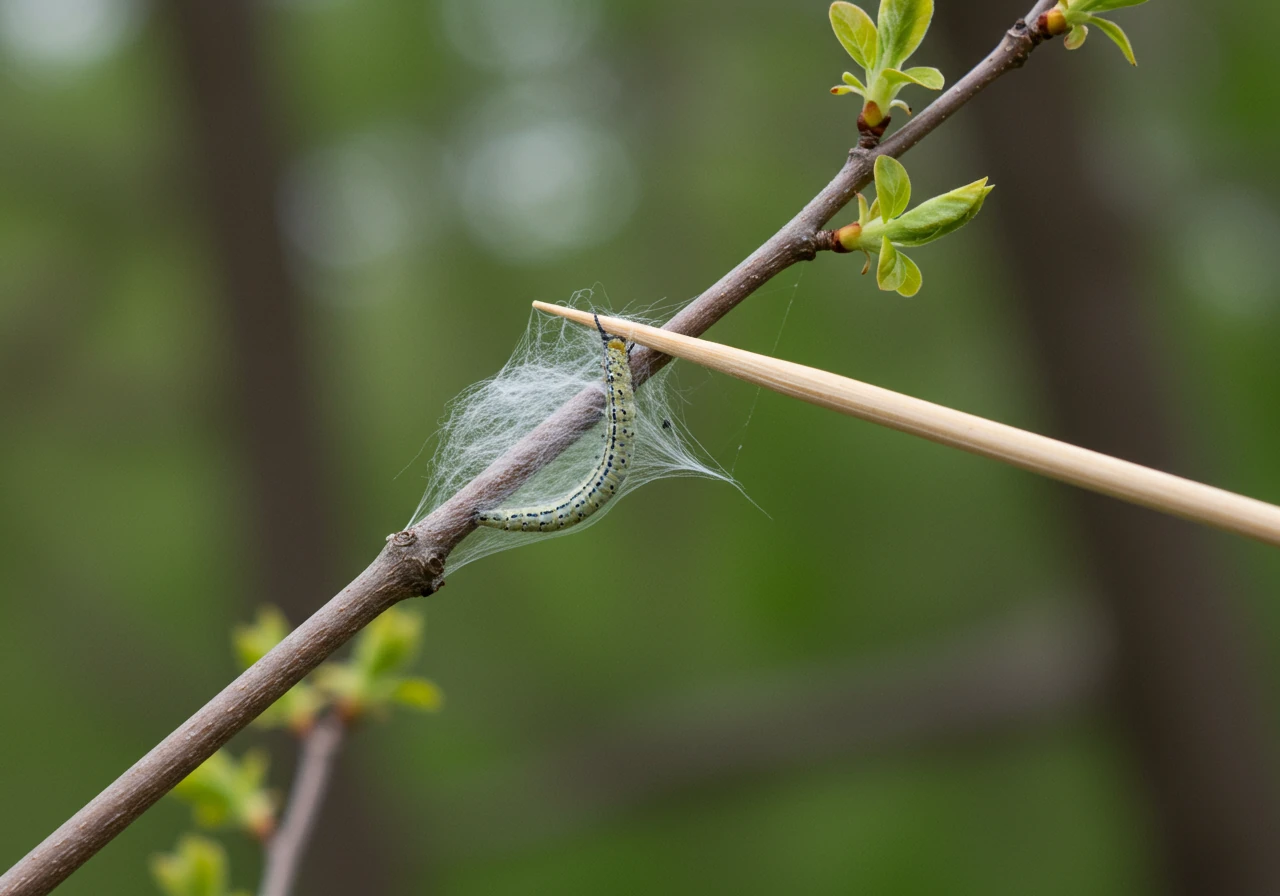
Right, so despite your best detective work, a few (or maybe more than a few!) of those fuzzy tent caterpillars slipped through and have started setting up camp. Don't panic! Catching them while the tents are small and the caterpillars are young is your next best move. It's like finding a small weed – easier to pull now than dealing with a jungle later. Let's get into some practical gardening strategies for these active critters, common sights from suburban Ottawa yards to larger properties out near Osgoode.
Operation Tent Takedown (Physical Removal)
This is often the most effective and eco-friendly approach when tents are reachable and haven't become massive condo complexes yet.
- Choose Your Moment: The best time to strike is early morning, late evening, or during cool, rainy weather. Why? Because most of the caterpillars will be snug inside their tent, making removal much more efficient. Sneaky, right?
- Gear Up: Put on some gloves – while not poisonous, some people find the fuzz irritating, and it's just... cleaner.
- The Tools: You don't need anything fancy. A long stick, a broom handle, or a specialized pole pruner can work. Your goal is to physically snag the tent.
- The Method: Carefully wrap or twist the stick around the tent structure, pulling it gently but firmly away from the branches. Try to get as much of the silk and as many caterpillars as possible in one go. Avoid breaking branches.
- Dispose of the Squatters: Immediately dunk the captured tent and caterpillars into a bucket of soapy water. The soap breaks the water's surface tension, ensuring they drown quickly. Don't just toss the tent on the ground – they might crawl back! Leaving the base of your trees clear, perhaps as part of regular care like proper professional mulching and edging services, makes accessing these lower tents much easier.
Introducing the Good Guy: Btk Spray
If physical removal isn't practical (maybe the tents are too high or too numerous), there's a targeted biological helper called Btk (Bacillus thuringiensis var. kurstaki).
- What it is: Btk is a naturally occurring soil bacterium. When eaten by specific types of caterpillars (like tent caterpillars), it damages their digestive system, causing them to stop feeding and die within a few days.
- Why it's Great: It's highly specific! Btk is harmless to people, pets, birds, bees, beneficial insects, and fish. This makes it a much better choice for responsible landscaping than broad-spectrum pesticides. Find out more about environmentally sound practices from organizations like OMAFRA.
- Timing is Crucial: Btk only works if the caterpillars *eat* it. This means you need to spray it onto the leaves *around* the tent, where the caterpillars will be feeding. It's most effective on young, small caterpillars. Once they get large and are about to leave the tent, Btk won't be very effective. Apply it on a dry, calm day when caterpillars are actively feeding (not holed up in the tent). Always follow label instructions precisely!
What NOT to Do (Please!)
- Don't Play with Fire: Never, ever try to burn the tents out of trees. It's incredibly dangerous (fire hazard!), rarely kills all the caterpillars, and severely damages or even kills the tree branch or the entire tree. Just don't.
- Avoid Broad-Spectrum Pesticides: Resist the urge to grab harsh chemical sprays. These kill beneficial insects (like pollinators and predators that naturally help control pests) along with the caterpillars, potentially causing more problems down the line and harming the local ecosystem.
Late Season & Rural Considerations
If you notice the tents very late in the season (late May/June) and the caterpillars are large and wandering away from the nest, removal is less impactful – they've already done most of their feeding. At this point, focusing on supporting tree health (watering, proper soil care) is more beneficial. In more rural areas like Kars or near Metcalfe, where wild cherry trees might be abundant, complete eradication might be unrealistic. You might focus control efforts on high-value ornamental trees near your home, accepting some caterpillar activity in more distant areas. Dealing with widespread pests can feel overwhelming, similar to tackling a big seasonal cleanup; sometimes, getting professional help like a dedicated Metcalf yard cleanup service or even a specific Metcalf garden clean up service can make a huge difference. Professional services are available across the region, including options like a Marionville garden clean up service for those further out. Keeping pests in check helps maintain the beauty you work towards, possibly envisioning future landscape transformations.
Hypothetical Control Method Effectiveness (Early Intervention)
*Illustrative effectiveness percentages. Actual results vary based on timing and thoroughness.*
Barrhaven Bug Battle: Quick Tips Box
Alright folks, those tent caterpillars might think they own the place, but we have a few tricks up our gardening sleeves! Here’s your quick-hit list for showing those fuzzy squatters who's boss, whether you're in Barrhaven, Nepean, or Greely:
- Scrape 'Em Early: Be a winter warrior! Hunt for those dark, shiny egg masses on twigs from late fall to early spring *before* leaves appear. Gently scrape them off and drop them in soapy water. Easiest win!
- Evict Tent Dwellers: See small, new tents? Act fast! On cool mornings or evenings, use a stick to twist the tent (and the caterpillars inside) right off the branch. Plunge the whole mess into soapy water immediately. Buh-bye, bugs!
- Use Btk Wisely: If tents are out of reach or too numerous, spray *Bacillus thuringiensis* var. *kurstaki* (Btk) on the *leaves* around the tents where *young* caterpillars feed. It’s safe for good bugs and birds but deadly to leaf-munching caterpillars. Timing is key – get them while they're small!
- Boost Tree Defences: Give your trees a fighting chance! Healthy trees bounce back faster. Focus on strong roots through good Soil preparation for healthy trees and proper watering. Resilient landscaping starts from the ground up.
- Know When to Call for Backup: Feeling overwhelmed, or the tents are sky-high? Sometimes calling in the pros is the best bet. If you need advice or hands-on help, don't hesitate to contact us (rest assured, we respect your details according to our privacy policy). Professional support, like a specialized Marionville garden clean up service or a broader Marionville yard cleanup service, shows help is available across the region for various yard care needs. See our customer feedback!
Beyond Your Yard: Eco-Friendly & Community Power
Okay, let's zoom out a bit! Tackling garden pests like tent caterpillars isn't just about your yard – it's about creating a healthier neighbourhood ecosystem, together. Think of it as building positive landscaping karma! It's amazing what a little eco-friendly effort and community spirit can achieve, right here in Ottawa.
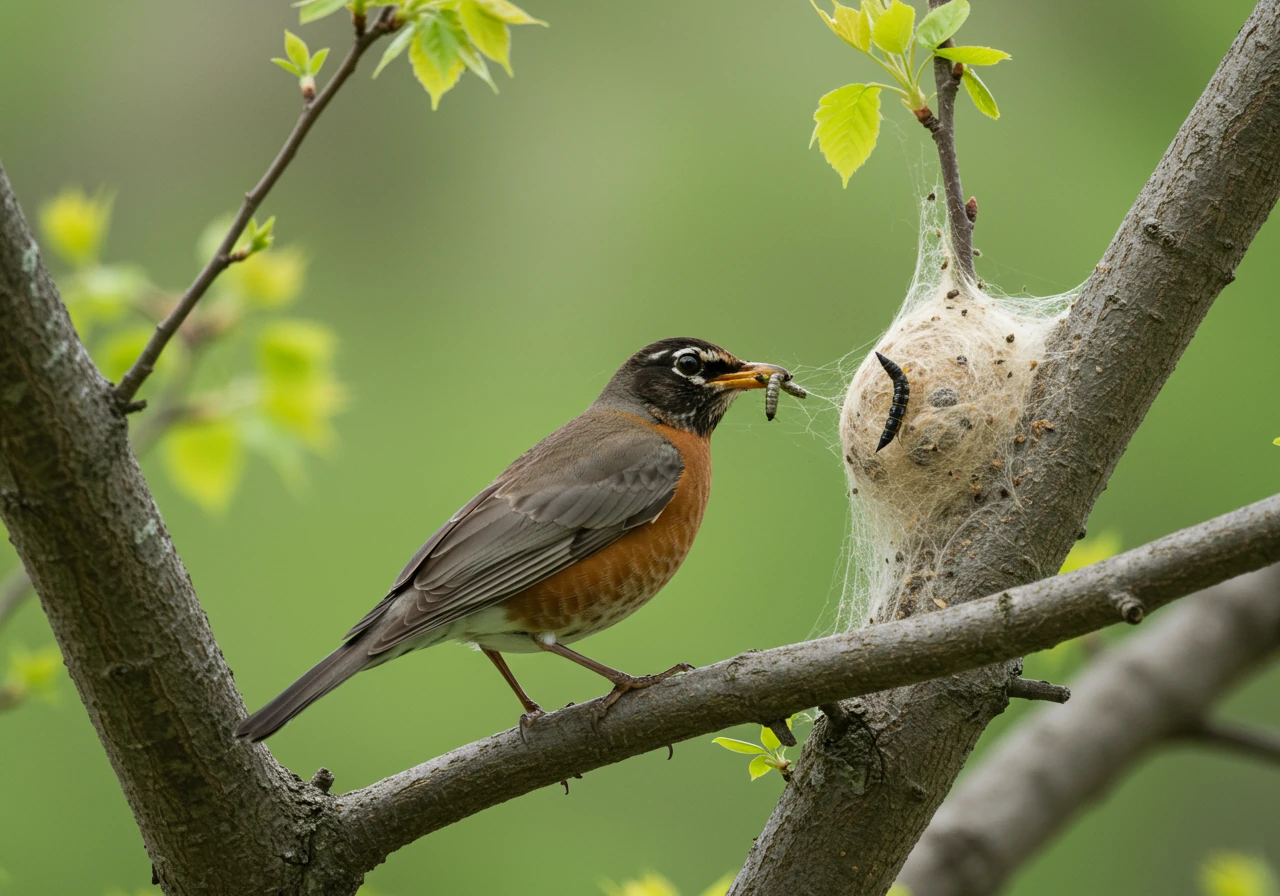
Invite the Cavalry: Attract Birds!
Your best allies in the fight against creepy crawlies? Birds! Many bird species find caterpillars absolutely delicious (protein power!). Encourage these feathered friends to hang out:
- Set the Table: Put up bird feeders (especially in winter/early spring) and provide a bird bath with fresh water. Check resources like the Canadian Wildlife Federation for tips.
- Plant Native: Consider adding native shrubs and trees to your gardening plan. Species that evolved here provide the best* food (berries, seeds, insects!) and shelter for local birds. Need help picking the right plants or getting them in the ground? Planning and executing a professional garden install focused on biodiversity can make a huge difference.
- Keep it Natural: Avoid broad-spectrum pesticides that harm birds and the insects they eat. Ongoing expert garden maintenance can help keep your yard healthy without resorting to harsh chemicals.
Strong Trees, Happy Neighbourhoods
Healthy trees are less stressed by pests. Beyond specific caterpillar tactics, general tree care is vital: proper watering (especially during dry Ottawa summers), mulching around the base (but not touching the trunk!), and ensuring good soil health. Think long-term resilience! This foundation supports all aspects of your yard, from flower beds needing Ottawa garden clean up service to larger landscapes requiring city property cleanup service.
Team Up with Neighbours!
Imagine this: you diligently remove caterpillar egg masses, but they hatch next door and wander over. Argh! This is where community power shines. Chat with your neighbours, especially if you're in a connected area like Barrhaven or Greely. Check local resources like the City of Ottawa's Tree Health page.
- Share the Knowledge: Let folks know about easy wins like scraping egg masses or the best time to tackle tents.
- Coordinate Efforts: Maybe agree to check trees on the same weekend. Many hands make light work!
- Think Bigger: Could your street pool resources for Btk application on larger trees, or even plan a shared native planting project? Getting everyone's input is key for success; just like providing feedback on service estimates, gathering community thoughts ensures projects meet collective goals.
- Beyond the Fence: Keeping shared spaces clean, like boulevards or park edges, also helps reduce pest havens. Sometimes larger areas need attention, similar to tasks handled by a professional city property cleanup service. This collective care benefits everyone, extending even to more rural communities needing support like a Marionville yard cleanup service. Consider our terms when coordinating group efforts.
By working together and focusing on sustainable practices, we can create healthier, more resilient, and frankly, more beautiful neighbourhoods for everyone – birds included! Thanks for doing your part; check our thank you page for more resources.
Ottawa Tent Caterpillar FAQs: Your Questions Answered
You'll typically spot Eastern Tent Caterpillar tents forming in Ottawa neighbourhoods like Barrhaven from late April to early June, right when trees are putting out fresh spring leaves. The best time to act is early: scrape off egg masses *before* leaves emerge (winter/early spring), or physically remove small tents as soon as you see them. Don't wait until they build mansions! Early gardening vigilance saves trouble later.
Good question, but nope, different party crashers! Eastern Tent Caterpillars (ETCs) make those obvious silky tents *in* branch forks (like tree armpits!) and have a solid white stripe down their back. LDD (Lymantria dispar dispar, formerly Gypsy Moth) caterpillars have pairs of red and blue dots and wander freely, no tents. Both require homeowner attention, and keeping your yard generally tidy through services like an Ottawa yard cleanup service can help spot issues early.
Take a breath – probably not! While a heavy infestation looks dramatic and defoliates branches, ETCs rarely kill healthy, established trees. The tree usually has enough energy reserves to push out new leaves later in the season. However, repeated heavy feeding *can* weaken trees, especially younger ones. Investing in overall tree health, sometimes starting with a proper garden install featuring resilient plants, gives them the best defence.
Not directly because of the water or fields themselves, but these areas often have more wild host trees (like chokecherry) that ETCs love. So, you might see higher populations nearby. Managing pests on larger properties, particularly those bordering wilder zones, might benefit from a thorough seasonal property clean up to remove potential overwintering spots and maintain clear landscaping areas. Similar challenges may arise in areas needing a Metcalf yard cleanup service.
Generally, no. The City of Ottawa's pest control programs usually target invasive species posing major ecological or economic threats. Since Eastern Tent Caterpillars are native and mainly an aesthetic nuisance, managing them on private trees falls to the homeowner. It's part of regular gardening and property upkeep to handle these common visitors, whether through DIY efforts or hiring a city garden clean up service.
Your best green weapons are your own hands (gloved, maybe!) and timing. Scraping egg masses off twigs in winter is super effective and non-toxic. Physically removing small, young tents into a bucket of soapy water is also excellent. If spraying is needed, Btk is a safe biological option affecting only caterpillars that eat it. Need more advice on eco-friendly solutions? You can learn more about us and our approach to responsible yard care.
Conclusion: Keep Your Barrhaven Yard Beautiful, Caterpillar-Free!
So there you have it, Barrhaven neighbours! Keeping those fuzzy tent crashers from turning your favourite trees into their personal buffet really comes down to being a bit proactive. Remember, spotting those sneaky egg masses during the winter or early spring is your secret weapon. And if you miss those, tackling the small, newly formed tents *before* they become caterpillar condos is much easier (and let's be honest, less squirmy!) than waiting until they're huge.
Putting in a little effort early means your trees stay healthier, your landscaping looks fantastic, and you spend less time worrying about leaf loss. It’s all about enjoying your beautiful outdoor space without uninvited, leaf-munching guests spoiling the view! A healthy, well-maintained yard adds so much enjoyment to life here in Ottawa.
- Feeling Overwhelmed or Need a Hand? Sometimes those tents are just too high, or life gets too busy for bug patrol. If you need help managing tent caterpillars or tackling any other gardening or landscape maintenance task in the Barrhaven area or across Ottawa, Clean Yards is happy to help! Visit our Services Page or Contact Us directly.
- Spread the Word! Found these tips useful? Why not share them with a friend or neighbour who might be dealing with their own fuzzy invasion? Knowledge is power, especially in the garden!
Here's to a beautiful, thriving, and caterpillar-managed spring and summer in your lovely Barrhaven yard!

